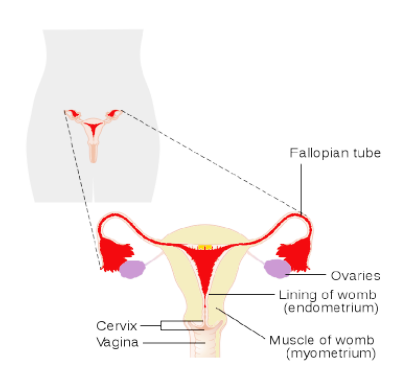
What is the site for fertilization in the human female reproductive system. Where does the zygote get implanted after fertilization?
Answer
500.7k+ views
Hint: Fertilization or fusion of sperm and egg occurs after the release of an ovum in the oviduct of the female reproductive tract. Following fertilization, the formed zygote gets implanted into one of the linings of the uterus which normally shed in menstrual flow in a non-pregnant woman.
Complete answer:

- The female reproductive tract or system consists of a pair of ovaries, a pair of oviducts (Fallopian tube), a uterus, a cervix, and a vagina.
- The ovary is the primary female sex organ where the egg or ova gets produced. Just after the ovary, the fallopian tube (oviduct) extends to the uterus which consists of three parts:
- The infundibulum is the funnel-shaped region present closer to the ovary. It bears finger-like projections called fimbriae to collect the ovum from the ovary.
- The ampulla is a wider part of the oviduct found just after the infundibulum towards the uterus.
- Isthmus is the narrowest part of the oviduct that ends at the uterus.
- The oviduct acts as a site of fertilization. More specifically, the ampullary-isthmic junction of the oviduct is the site of fertilization.
- The uterus is a hollow, muscular, inverted pear-shaped structure found in the pelvic region of the human female.
- The wall of the uterus is composed of three layers, outer perimetrium, middle muscular myometrium, and innermost highly vascular and glandular endometrium.
- The endometrium is the site of implantation because it has a blood supply and glands.
- So, the correct answer is that the site of fertilization is the ampullary-isthmic junction of the oviduct, and the endometrium of the uterus is the site for implantation of the zygote.
Note: One-celled zygote starts to divide through cleavage into millions of cells and at a stage, called the blastocyst, it implants into the endometrium of the uterus. The ampullary-isthmic junction is the site of fertilization and endometrium provides the site for implantation because it can provide oxygen and nutrients for the cleavage process until the embryo does not form the placenta.
Complete answer:

- The female reproductive tract or system consists of a pair of ovaries, a pair of oviducts (Fallopian tube), a uterus, a cervix, and a vagina.
- The ovary is the primary female sex organ where the egg or ova gets produced. Just after the ovary, the fallopian tube (oviduct) extends to the uterus which consists of three parts:
- The infundibulum is the funnel-shaped region present closer to the ovary. It bears finger-like projections called fimbriae to collect the ovum from the ovary.
- The ampulla is a wider part of the oviduct found just after the infundibulum towards the uterus.
- Isthmus is the narrowest part of the oviduct that ends at the uterus.
- The oviduct acts as a site of fertilization. More specifically, the ampullary-isthmic junction of the oviduct is the site of fertilization.
- The uterus is a hollow, muscular, inverted pear-shaped structure found in the pelvic region of the human female.
- The wall of the uterus is composed of three layers, outer perimetrium, middle muscular myometrium, and innermost highly vascular and glandular endometrium.
- The endometrium is the site of implantation because it has a blood supply and glands.
- So, the correct answer is that the site of fertilization is the ampullary-isthmic junction of the oviduct, and the endometrium of the uterus is the site for implantation of the zygote.
Note: One-celled zygote starts to divide through cleavage into millions of cells and at a stage, called the blastocyst, it implants into the endometrium of the uterus. The ampullary-isthmic junction is the site of fertilization and endometrium provides the site for implantation because it can provide oxygen and nutrients for the cleavage process until the embryo does not form the placenta.
Recently Updated Pages
Master Class 4 Maths: Engaging Questions & Answers for Success

Master Class 4 English: Engaging Questions & Answers for Success

Master Class 4 Science: Engaging Questions & Answers for Success

Class 4 Question and Answer - Your Ultimate Solutions Guide

Master Class 11 Economics: Engaging Questions & Answers for Success

Master Class 11 Business Studies: Engaging Questions & Answers for Success

Trending doubts
Give 10 examples of unisexual and bisexual flowers

Draw a labelled sketch of the human eye class 12 physics CBSE

Differentiate between homogeneous and heterogeneous class 12 chemistry CBSE

Differentiate between insitu conservation and exsitu class 12 biology CBSE

What are the major means of transport Explain each class 12 social science CBSE

What is the difference between resemblance and sem class 12 social science CBSE




